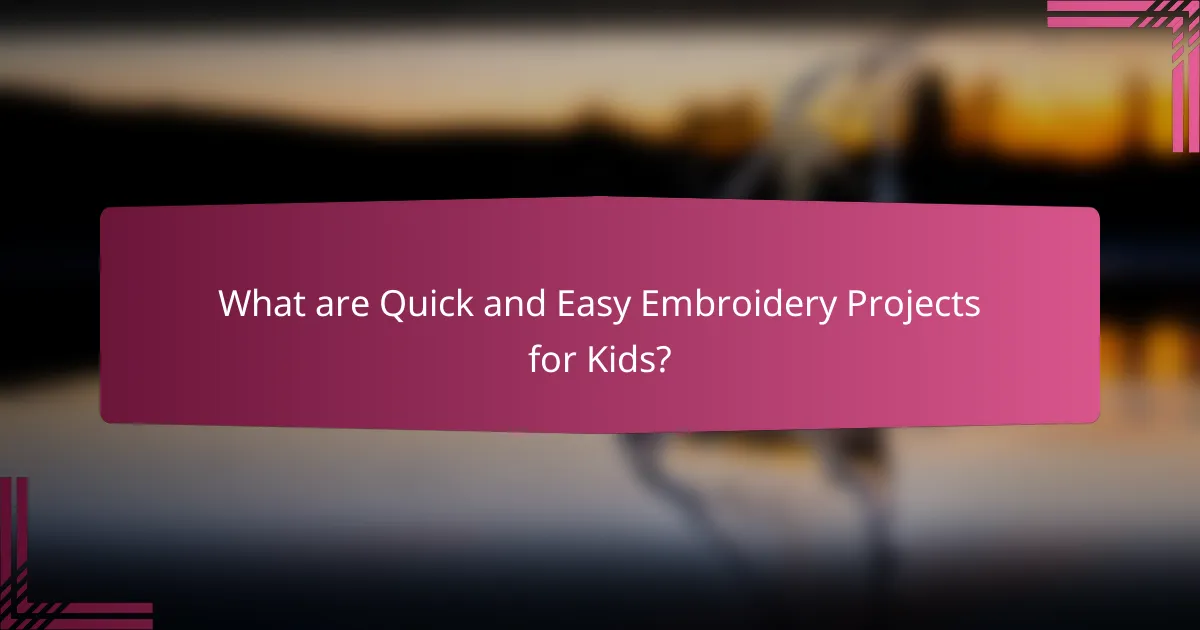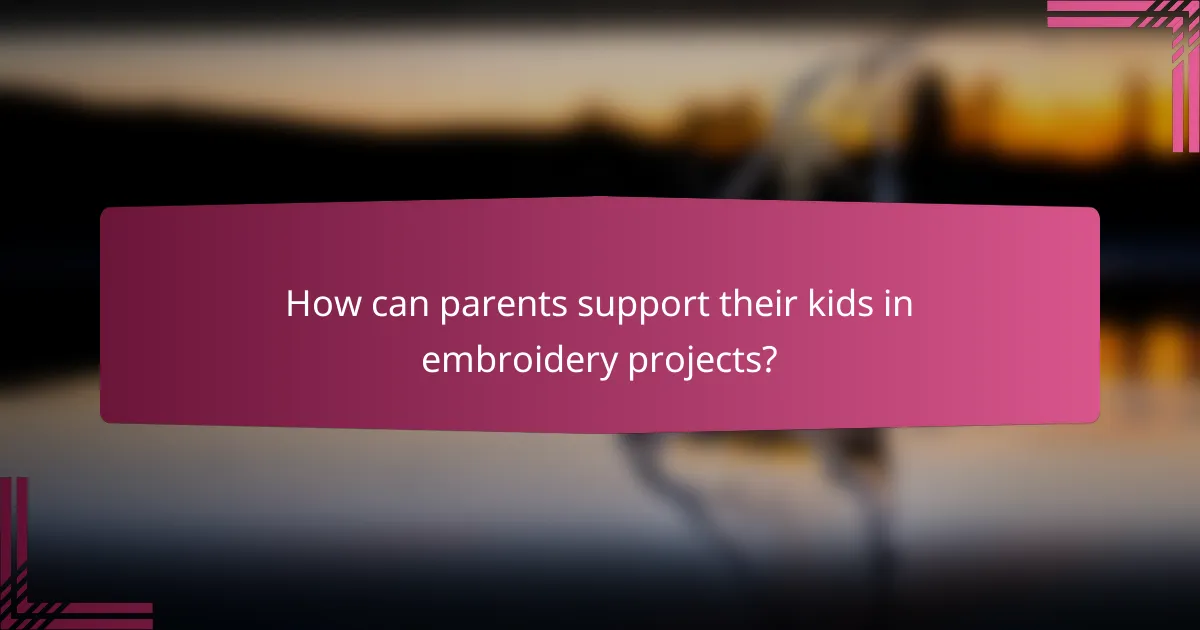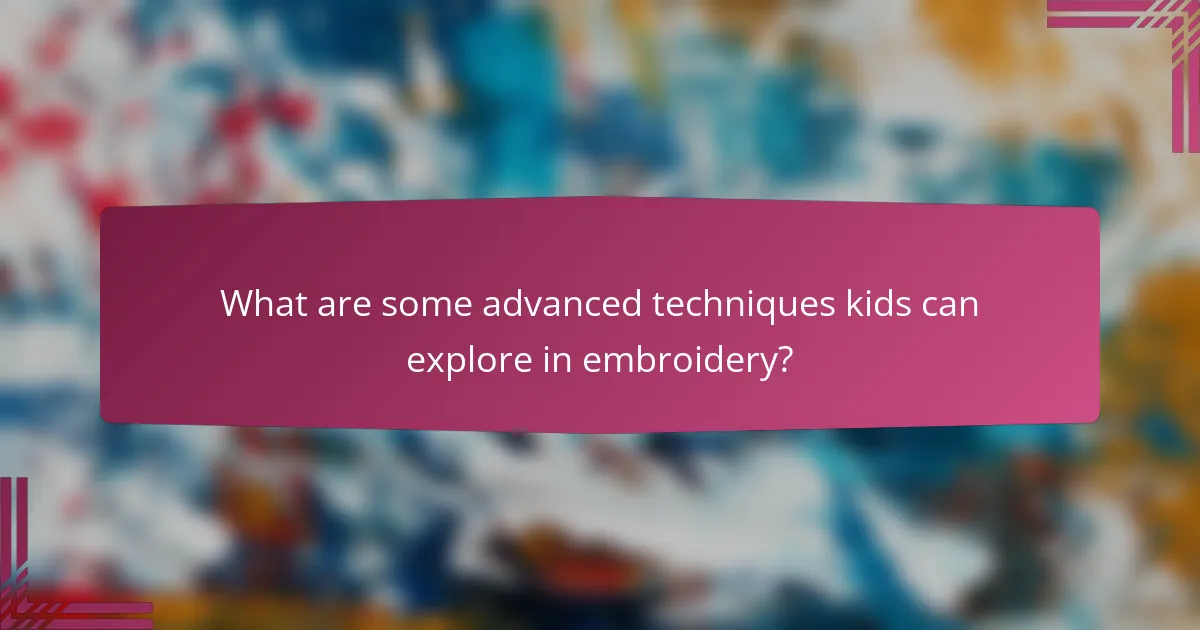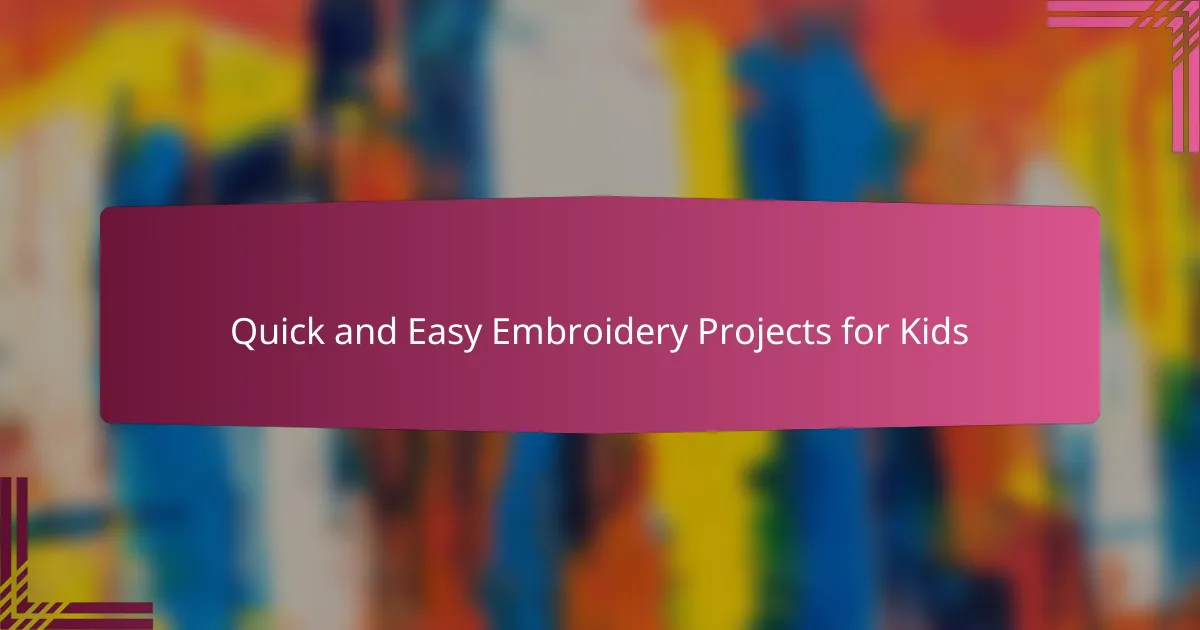
What are Quick and Easy Embroidery Projects for Kids?
Quick and easy embroidery projects for kids include simple designs like bookmarks, keychains, and small patches. These projects require minimal materials and basic stitching techniques. Kids can use embroidery hoops and colorful threads for added fun. Projects like flower motifs or simple animals are engaging and age-appropriate. Many tutorials are available online, guiding children step-by-step. These activities enhance fine motor skills and creativity. They also provide a sense of accomplishment upon completion. Overall, these projects are perfect for introducing kids to embroidery.
How can embroidery projects benefit children’s development?
Embroidery projects can significantly benefit children’s development. They enhance fine motor skills through the manipulation of needles and threads. This activity requires precision and coordination, which are crucial for hand-eye coordination. Additionally, embroidery fosters creativity by allowing children to design their own patterns and color choices. It also promotes patience and focus, as completing a project takes time and concentration. Furthermore, working on embroidery can boost self-esteem when children see the tangible results of their efforts. Research shows that engaging in crafts like embroidery can improve cognitive skills, as it involves problem-solving and planning. Overall, embroidery projects provide a multifaceted approach to child development.
What skills can children learn through embroidery?
Children can learn various skills through embroidery. These skills include fine motor skills, as they practice hand-eye coordination while threading needles and stitching. They also develop patience and focus, which are essential for completing intricate designs. Creativity is enhanced as children choose colors and patterns for their projects. Additionally, problem-solving skills emerge when they encounter challenges in their work. Social skills can improve through collaborative embroidery projects with peers. Lastly, children gain a sense of accomplishment upon completing their embroidery, boosting their self-esteem.
Why is embroidery a good creative outlet for kids?
Embroidery is a good creative outlet for kids because it fosters fine motor skills and enhances concentration. Engaging in embroidery requires children to use their hands in precise movements. This practice helps improve hand-eye coordination over time. Additionally, embroidery allows kids to express their creativity through design choices. They can choose colors, patterns, and stitches, promoting individual expression. Research indicates that creative activities like embroidery can boost self-esteem in children. Completing a project gives a sense of accomplishment, reinforcing their confidence. Overall, embroidery combines skill development with creative expression, making it an excellent choice for kids.
What materials are needed for simple embroidery projects?
Simple embroidery projects require a few basic materials. Essential items include embroidery floss, which comes in various colors. You will also need a needle, preferably a sharp embroidery needle. Fabric is necessary, such as cotton or linen, which provides a good surface for stitching. An embroidery hoop helps keep the fabric taut while you work. Scissors are needed for cutting threads and fabric. Lastly, a pattern or design guide can assist in creating your project. These materials are commonly used in beginner embroidery projects.
What types of fabric are best for kids’ embroidery projects?
Cotton fabric is best for kids’ embroidery projects. It is easy to handle and provides a stable surface for stitching. Cotton is also widely available in various colors and patterns. Another good option is felt, which is thick and does not fray. Felt is forgiving for beginners and adds texture to projects. Aida cloth is another suitable choice, especially for cross-stitching. It features a grid pattern that makes counting stitches easier. These fabrics are safe and comfortable for children to work with.
What embroidery tools should beginners have?
Beginners should have a basic set of embroidery tools to start their projects. Essential tools include embroidery needles, which are designed with larger eyes for easy threading. Embroidery floss is necessary, as it comes in various colors and is used for stitching. A pair of scissors is important for trimming threads and finishing projects neatly. An embroidery hoop helps keep fabric taut while stitching, ensuring even tension. Fabric markers or chalk are useful for marking designs on fabric before stitching. Finally, a pattern guide can assist beginners in following designs accurately. These tools provide a solid foundation for starting embroidery projects.
What are some popular quick and easy embroidery projects for kids?
Some popular quick and easy embroidery projects for kids include simple bookmarks, embroidered keychains, and small hoop art. Bookmarks can be made using felt or fabric, allowing kids to practice basic stitches. Keychains can be personalized with initials or shapes, making them fun and functional. Small hoop art projects encourage creativity, as children can design their own patterns. These projects typically require minimal materials and can be completed in a short amount of time. They also help develop fine motor skills and introduce children to the art of embroidery.
How can kids create personalized bookmarks through embroidery?
Kids can create personalized bookmarks through embroidery by following simple steps. First, they need to select a piece of fabric as the base. Next, they can cut the fabric into a rectangular shape suitable for a bookmark. After that, kids should choose embroidery thread in their favorite colors. They can then use a needle to stitch their names or designs onto the fabric. Simple stitches like backstitch or running stitch are effective for beginners. Once finished, kids can add embellishments like beads or ribbons for extra flair. This engaging activity enhances their creativity and fine motor skills.
What steps are involved in making embroidered patches?
The steps involved in making embroidered patches include designing the patch, selecting materials, and preparing the fabric. First, create a design that fits the desired size and theme. Next, choose fabric, thread, and stabilizer that suit the design. Cut the fabric into the desired shape and size. Then, place the stabilizer behind the fabric to support the stitching. Afterward, use an embroidery machine or hand stitch the design onto the fabric. Finally, trim the patch and apply a backing if needed. Each step ensures a quality embroidered patch suitable for various uses.

How can parents support their kids in embroidery projects?
Parents can support their kids in embroidery projects by providing necessary materials and guidance. They should gather supplies like embroidery hoops, threads, and needles. Parents can also help set up a comfortable workspace for their children. Encouragement is essential; praising efforts boosts confidence. Teaching basic stitches can enhance skill development. Parents should show interest in the projects to foster creativity. Sharing resources like books or online tutorials is beneficial. Engaging in the projects together can create bonding experiences.
What tips can parents follow to encourage their children?
Parents can encourage their children by providing positive reinforcement. Praise their efforts and achievements, no matter how small. Create a supportive environment that fosters creativity. Allow children to express themselves through their embroidery projects. Set achievable goals to build their confidence. Offer assistance when needed, but encourage independence. Share your own enthusiasm for embroidery to inspire them. Engage in embroidery activities together to strengthen your bond.
How can parents provide the right environment for crafting?
Parents can provide the right environment for crafting by creating a designated crafting space. This area should be well-lit and organized. Parents should supply a variety of crafting materials. These can include fabrics, threads, and embroidery tools. Safety should be a priority, ensuring that materials are age-appropriate. Encouragement of creativity is essential; parents should allow children to express themselves freely. Additionally, setting aside regular crafting time can enhance engagement. Providing guidance while allowing independence fosters confidence in crafting skills.
What role does supervision play in kids’ embroidery projects?
Supervision plays a crucial role in kids’ embroidery projects. It ensures safety by preventing accidents with sharp needles and scissors. Supervision also provides guidance on techniques and stitches, enhancing skill development. Children can receive immediate feedback, which fosters learning and confidence. Additionally, [censured] oversight encourages creativity while maintaining focus on the task. Supervision helps manage time effectively, ensuring projects are completed. Engaged adults can also facilitate discussions about design choices, promoting critical thinking. Overall, supervision enriches the embroidery experience for children, making it both enjoyable and educational.
What safety precautions should be taken during embroidery?
Use safety scissors to prevent cuts during embroidery. Ensure that children are supervised while using sharp tools. Keep the workspace organized to avoid tripping hazards. Use non-toxic materials to prevent allergic reactions. Store needles and pins safely to avoid accidental injuries. Make sure to use proper posture to prevent strain. Educate children on the safe handling of tools and materials. These precautions help ensure a safe and enjoyable embroidery experience.
What tools require special attention for safety?
Tools that require special attention for safety in embroidery projects include scissors, needles, and sewing machines. Scissors can cause cuts if not handled properly. Needles pose a risk of puncture wounds. Sewing machines can lead to finger injuries if safety precautions are ignored. Using safety scissors designed for children can minimize risks. Supervision is essential when kids use sharp tools. Proper storage of tools prevents accidental injuries. Educating children on safe handling practices is crucial.
How can parents teach kids to handle needles safely?
Parents can teach kids to handle needles safely by demonstrating proper techniques. Start by explaining the purpose of the needle in embroidery. Show how to hold the needle correctly and guide them on how to thread it. Emphasize the importance of keeping fingers away from the sharp end. Teach them to always use a thimble when pushing the needle through fabric. Supervise their practice sessions closely to ensure safe handling. Reinforce the need for a designated workspace to minimize accidents. Encourage them to ask for help if they feel unsure. Providing a safe environment helps build their confidence in using needles.

What are some advanced techniques kids can explore in embroidery?
Kids can explore several advanced techniques in embroidery. Techniques include free-motion embroidery, where kids can create unique designs by moving the fabric freely under the needle. Another technique is appliqué, which involves sewing fabric shapes onto a base fabric for added texture. Kids can also experiment with thread painting, where they use various stitches to create a painted effect with thread. They can learn to use different types of stitches, such as French knots and satin stitches, for more intricate designs. Additionally, kids can explore the use of mixed media, combining embroidery with other art forms like fabric painting or beading. These techniques enhance creativity and skill in embroidery projects.
How can children transition from basic to more complex designs?
Children can transition from basic to more complex designs by gradually introducing new techniques and patterns. Start with simple stitches like straight and zigzag. Once they master these, introduce more intricate stitches such as French knots and satin stitches. Encourage them to experiment with color combinations and layering techniques. Provide templates for more complex designs to guide their creativity. As their confidence grows, allow them to create their own designs. This method builds skills progressively and keeps their interest high. Studies show that gradual skill development enhances learning and retention in children.
What are some beginner-friendly patterns for advanced projects?
Beginner-friendly patterns for advanced embroidery projects include simple geometric shapes, basic floral designs, and monogramming. Geometric shapes like triangles and circles are easy to stitch and can be combined for intricate designs. Basic floral designs allow for creativity while using straightforward stitches like satin and backstitch. Monogramming introduces personalization and can be done with simple letters. These patterns help build confidence and skill for more complex projects later. They provide a foundation in techniques that can be expanded upon as the embroiderer gains experience.
How can kids learn about color theory in embroidery?
Kids can learn about color theory in embroidery through hands-on projects. Engaging in simple embroidery tasks allows them to experiment with color combinations. They can use a color wheel to understand primary, secondary, and complementary colors. By selecting thread colors based on these principles, children can see how colors interact. Creating patterns with contrasting colors can enhance their visual appeal. Additionally, kids can explore the emotional impact of colors in their designs. This practical experience reinforces theoretical concepts. Educational resources like books and online tutorials can also provide guidance.
What resources are available for learning embroidery techniques?
Books on embroidery techniques are widely available. Titles such as “Embroidery for Beginners” provide step-by-step instructions. Online platforms like YouTube offer video tutorials for visual learners. Websites dedicated to crafting often have free patterns and guides. Local craft stores may host workshops for hands-on learning. Social media groups can connect learners with experienced embroiderers. Additionally, online courses from platforms like Skillshare teach specific techniques. These resources collectively support various learning styles and preferences in embroidery.
Where can kids find online tutorials for embroidery projects?
Kids can find online tutorials for embroidery projects on various platforms. Websites like YouTube offer numerous video tutorials tailored for children. Additionally, platforms such as Skillshare and Udemy provide structured courses for beginners. Blogs focused on crafting often feature step-by-step guides. Websites like Pinterest showcase a variety of embroidery ideas with links to tutorials. These resources cater specifically to younger audiences, making learning accessible and fun.
What books are recommended for young aspiring embroiderers?
“Stitch by Stitch: A Beginner’s Guide to Embroidery” is recommended for young aspiring embroiderers. This book provides clear instructions and colorful illustrations. It covers basic stitches and techniques suitable for beginners. Another excellent choice is “Embroidered Treasures: A Beginner’s Guide to Stitching” which offers fun projects. This book encourages creativity and hands-on learning. “The Ultimate Beginner’s Guide to Embroidery” is also recommended. It includes step-by-step tutorials and helpful tips. Each of these books is designed to engage children and foster their interest in embroidery.
What are some best practices for successful embroidery projects?
Successful embroidery projects require careful planning and execution. Start with selecting the right fabric. Cotton is often recommended for beginners due to its ease of handling. Choose high-quality threads to ensure durability and vibrant colors. Use appropriate needle sizes for your fabric type. This prevents damage and ensures smooth stitching.
Pre-wash fabric to eliminate shrinkage and remove any chemicals. This step helps maintain the integrity of the embroidery. Mark your design accurately on the fabric. This provides a clear guide for stitching.
Maintain consistent tension while stitching. This ensures even stitches and a polished look. Regularly check your work for mistakes. Fixing errors early prevents larger issues later. Lastly, practice on scrap fabric before starting the final project. This builds confidence and hones skills.
Quick and easy embroidery projects for kids involve simple designs such as bookmarks, keychains, and small patches that require minimal materials and basic stitching techniques. These projects enhance fine motor skills, creativity, and self-esteem, making them ideal for young learners. The article covers essential materials, beginner-friendly patterns, safety precautions, and advanced techniques, providing parents with guidance on how to support their children’s embroidery journey. Additionally, it highlights the developmental benefits of embroidery, including improved coordination, patience, and problem-solving skills.
